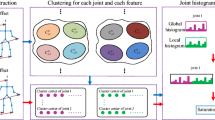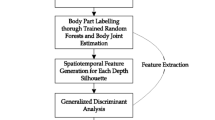Abstract
Recognizing detailed human behavior expands the possibilities of anomaly-detection systems and health-management systems. In recent years, activity recognition using skeletal-recognition technology has been studied. In these studies, human activity is divided into data for classifying human behavior. Human activity was learned as one-label action data of the whole body. However, the action of the whole body should not be represented by a single label, because it consists of the behaviors of individual parts, such as the arms and legs. Also, human activity includes parallel actions, such as walking while carrying something. This study divides human joints into six groups. Our method produces histograms of the action data and learns it with histograms of each group. It then integrates these histograms collaboratively by labeling the overall operation. We conducted experiments to verify the effectiveness of our proposed method. Finally, we made a dataset of actions similar to that of Xia et al. (View Invariant Human Action Recognition Using Histograms of 3D Joints, the 2nd International Workshop on Human Activity Understanding from 3D Data (HAU3D) in conjunction with IEEE CVPR. Providence Rhode Island, 2012), and evaluated the histograms to determine whether the feature extraction has characters in each histogram by Random Forest. As a result, we found that the histogram has large feature when action has large motion, and we concluded that imposing a penalty on the inferred value is effective for occlusions.








Similar content being viewed by others
Explore related subjects
Discover the latest articles, news and stories from top researchers in related subjects.References
TOSHIBA Research and Development with a smart phone (2013) TOSHIBA review paper, vol 68, no 6, pp 40–43 (in Japan). http://www.toshiba.co.jp/tech/review/2013/06/68_06pdf/
Shotton J et al (2011) Real-time human pose recognition in parts from single depth images. In: CVPR
Taylor J et al (2012) The Vitruvian Manifold: Inferring Dense Correspondences for One-Shot Human Pose Estimation. IEEE Conference on Computer Vision and Pattern Recognition (CVPR 2012). pp 103–110
Breiman L (2001) Random Forests. Mach Learn 45(1):5–32
Rumner Y, Tomas C, Guibas LJ (2012) The Earth Mover’s Distance as a Metric for Image Retrieval. int J Compt Vis 40(2):99–121
Dalal N, Triggs B (2005) Histograms of Oriented Gradients for Human Detection. In: CVPR. pp 886–893
Inamura T, Nakamura Y, Toshima I, Ezaki H (2004) An Integrated Model of Imitation Learning and Symbol Emergence based on Mimesis Theory. The Robotics Society of Japan. pp 256–263
Xia L et al (2012) View Invariant Human Action Recognition Using Histograms of 3D Joints, the 2nd International Workshop on Human Activity Understanding from 3D Data (HAU3D) in conjunction with IEEE CVPR 2012. Providence Rhode Island
Wang J et al (2012) Mining Actionlet Ensemble for Action Recognition with Depth Cameras. In: IEEE Conference on Computer Vision and Pattern Recognition (CVPR 2012)
Shen W et al (2012) Exemplar-Based Human Action Pose Correction and Tagging. In: IEEE Conference on Computer Vision and Pattern Recognition (CVPR 2012)
Mori T et al (2004) Segmentation of sequential daily-actions based on hidden Markov models and human body hierachy. In: Proc. International Workshop on Man-Mashine Symbiotic Systems. pp 207–218
Author information
Authors and Affiliations
Corresponding author
Additional information
This work was presented in part at the 19th International Symposium on Artificial Life and Robotics, Beppu, Oita, January 22–24, 2014.
About this article
Cite this article
Saito, Y., Nishiyama, H. Design of a collaborative method with specified body regions for activity recognition: generating a divided histogram considering occlusion. Artif Life Robotics 20, 129–136 (2015). https://doi.org/10.1007/s10015-015-0206-0
Received:
Accepted:
Published:
Issue Date:
DOI: https://doi.org/10.1007/s10015-015-0206-0




